Climate-Driven or Human-Induced: Indicating Severe Water Scarcity in the Moulouya River Basin (Morocco)
Abstract
:1. Introduction

2. Contextual Background
2.1. The Case Study Area—Moulouya River Basin in North-Eastern Morocco
2.2. Measuring Water Scarcity—Indicators, Approaches, Limitations and Critique
| Index (year) | Approach and benefits | Limitations |
|---|---|---|
| Falkenmark Water Stress Index (1989) [8] | ● Total annual renewable water resources available to the population (per cap/year freshwater availability). ● Determines thresholds for minimum per capita water requirements. ● Data most often available as well on regional or smaller scales. ● Easy to apply and intuitively understandable. | ● Focus on blue water stress only, omits green water. ● Excludes main drivers for water scarcity, e.g., demand, efficiency, management and lifestyles. ● Societal adaptive capacity is not included. ● Assumes that all countries globally use or need the same amount of water for development. |
| Social Water Stress Index (2000) [46] | ● Builds on the Falkenmark indicator and applies the UNDP’s Human Development Index (HDI) to depict the social dimension of water scarcity. ● Contextualizes water stress with a low social adaptive capacity. | ● The HDI does not include ecological factors and focuses mainly on economic criteria [50]. ● The HDI does not depict intra-national differences, as the data applied is country-based only. |
| Water Resources Vulnerability Index (criticality ratio) (2000) [47] | ● Withdrawal-Ratio of human water use to total renewable water resources. ● Comparison of country-specific water demand and availability. ● Scarcity: proportion of total withdrawals relative to total available resources. | ● Role of non-natural resources (e.g., desalinization), recycled or re-used water is not considered. ● Omits behavioral change as a reaction towards lowering water capacities, e.g., the implementation of new technologies. |
| Physical and Economical Scarcity Indicators (2007) [11] | ● Accounts for all renewable water resources available for primary supply under future scenarios of improved water management policies, e.g., infrastructure development and irrigation efficiency. ● Physical scarcity: countries being unable to meet future demands despite future adaptive capacity (e.g., investments in water infrastructures). ● Economical scarcity: countries unable to meet future water demand without investments in water infrastructures despite sufficient renewable resources. | ● Measuring of indicator is very complex and time-consuming. ● Data requirements difficult to meet, thus it’s mainly based on expert judgments. ● Omits ability to adapt by virtual water imports (food) or water saving devices. ● Partly green and blue water are summed up, providing too high potential availability values. ● Country-based aggregated analysis. |
| Water Poverty Index (2003) [31] | ● Determines water security at household and community level based on income and wealth. ● Measures and aggregates five dimensions: level of access to water; water quantity, quality and variability; water used for domestic, food, and productive purposes; capacity for water management; environmental aspects. | ● Focuses on limitations of the Falkenmark Index. ● Comprehensive amounts of data required. ● Approach of high complexity. ● Lacks intuitive understanding. ● Suited for smaller rather than national scales. |
- It does not differentiate between countries regarding their specific water stress thresholds (one country might be able to handle a 500 m3 per capita annual availability; another might be experiencing severe water problems at that level);
- It focuses on natural freshwater availability only and does not include man-made freshwater sources (e.g., desalinization) or the accessibility of water;
Indicating Water Stress with the Falkenmark Index (FI)
| Water availability (per capita in m3)a | Level of water stress | Water resource management problems and constraints |
|---|---|---|
| >1700 | Occasional or local water stress | No or limited problems |
| 1700–1000 | Regular water stress | Heavy pressures on water resources, general management problems |
| 1000–500 | Chronic water scarcity | Chronic water shortages/limitation to economic development and human health and well-being |
| <500 | Absolute water scarcity | Beyond availability limit; beyond the water barrier of manageable capability, main constraint to life |
3. Methodology
3.1. Data
3.2. Indicators for Regional Water Availability in the Moulouya River Basin
3.2.1. Precipitation and Temperature Trends
3.2.2. Potential Evapotranspiration (Pot.ET) in the Moulouya River Basin



3.2.3. The Climatic Water Balance (CWB) in the Moulouya River Basin
3.2.4. Regional Population Trend
3.2.5 Calculation of Regional Per Capita Water Availability for 2006–2040
4. Results
4.1 Climate Impacts on the Water Regional Budget
| Season | DJF | MAM | JJA | SON |
|---|---|---|---|---|
| Seasonal mean in mm 1971–2005 (reference baseline 1936–1970) | 145 (124) | 110 (111) | 18 (20) | 89 (83) |
| Trend (change) | −21% | 0 | 2% | −6% |
| Statistical significance (α = 0.05) | 0.024 | 0.77 | 0.13 | 0.096 |
| Significance level | Highly significant | not | not | Slightly significant |


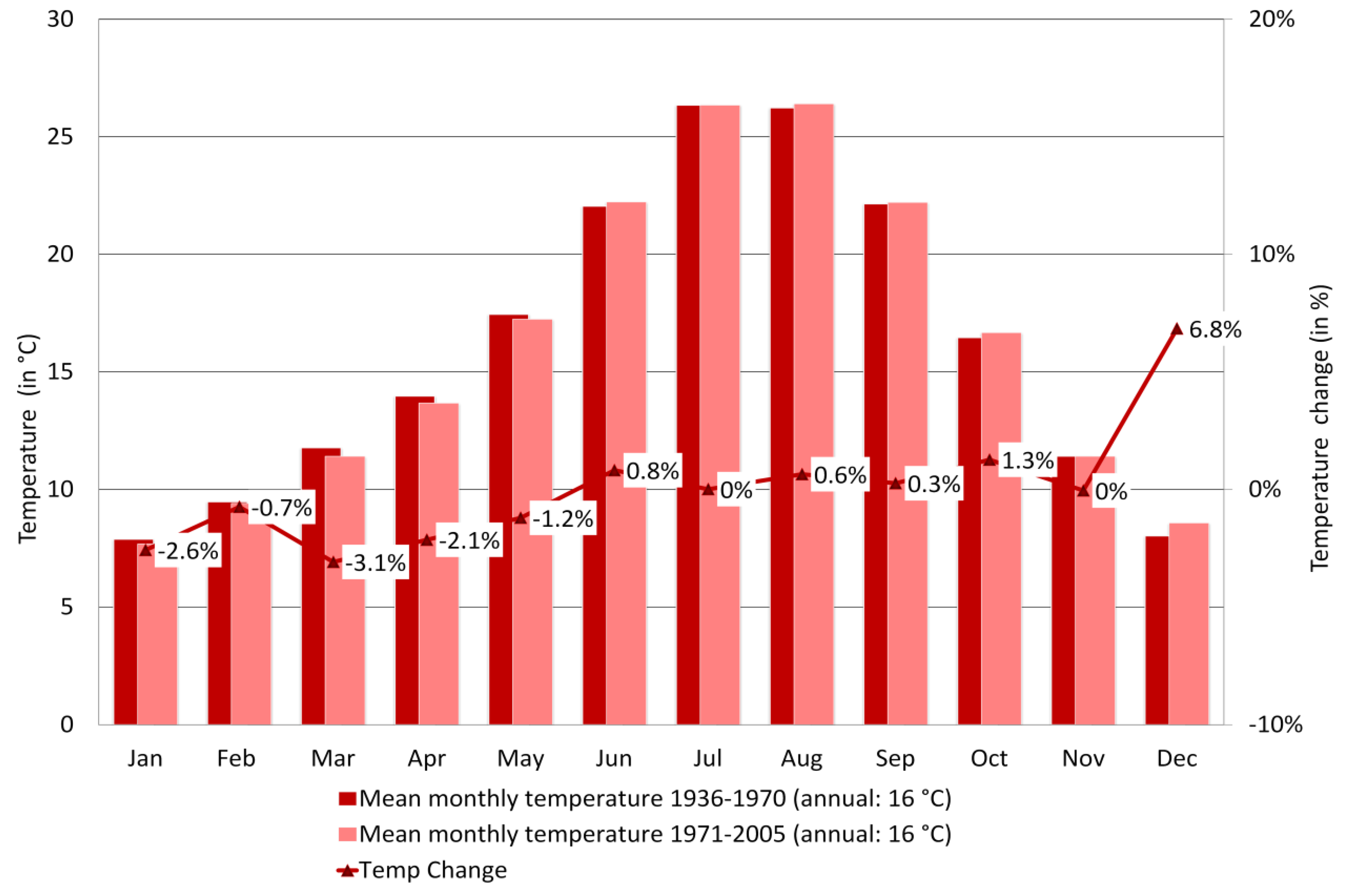
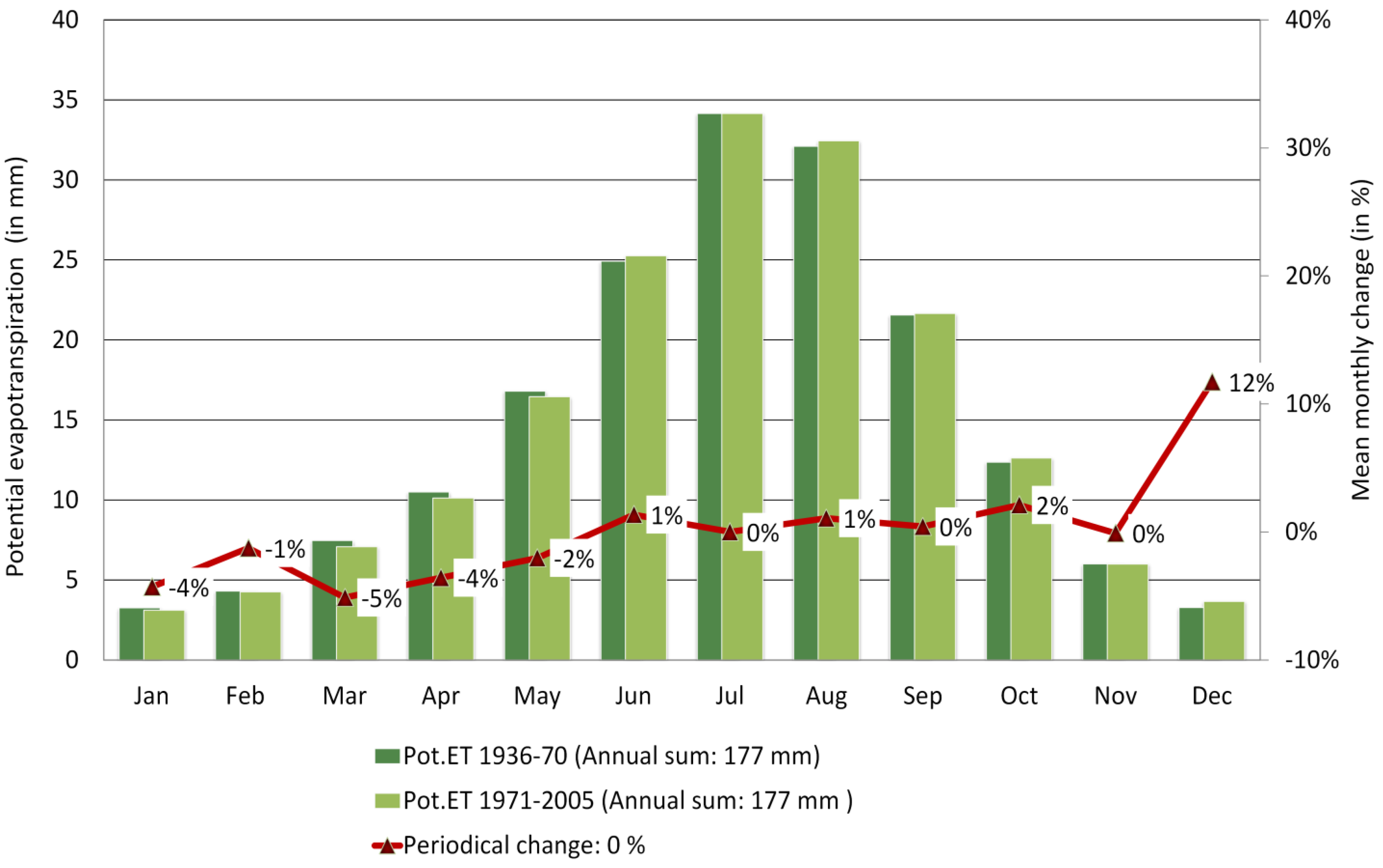
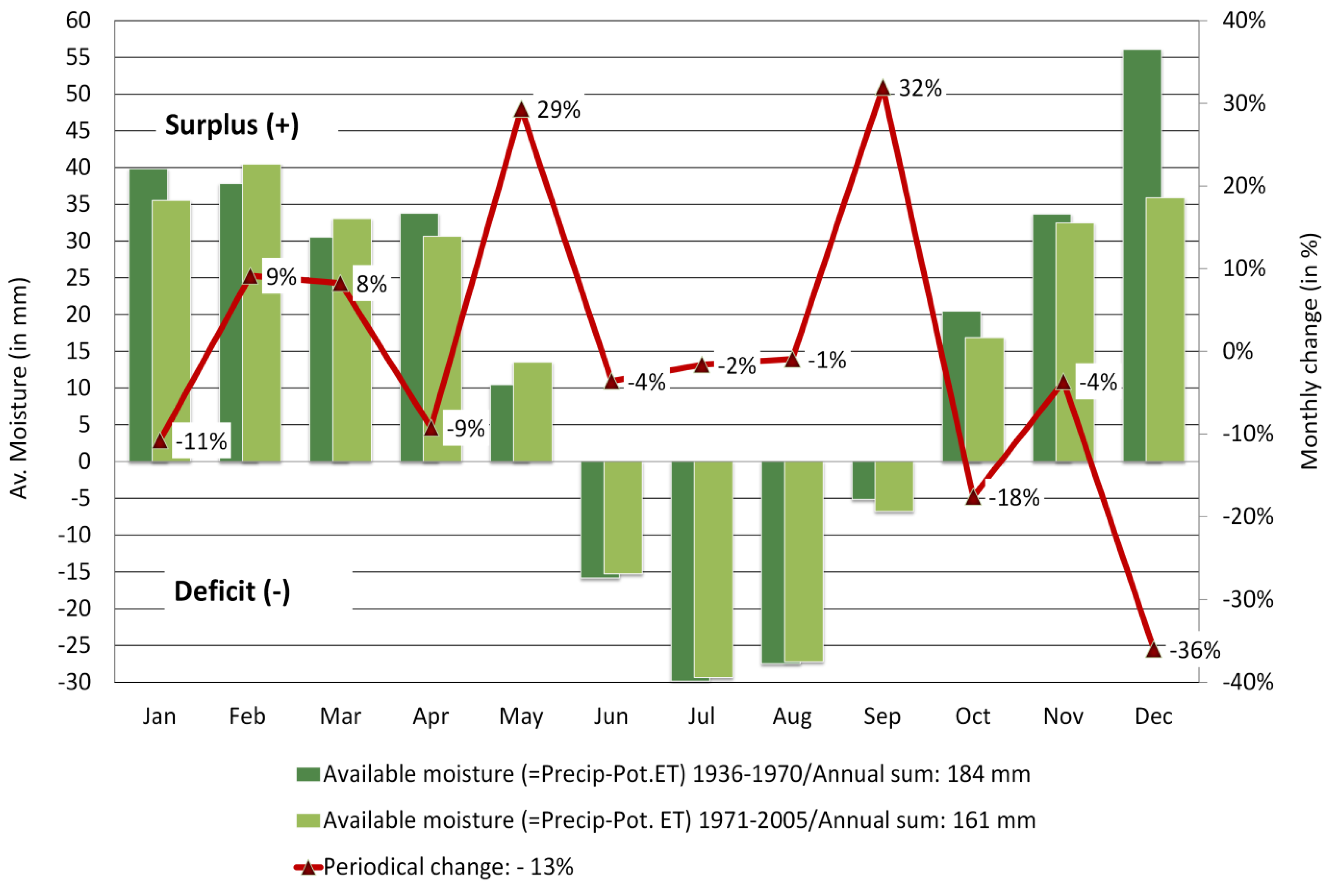
4.2 Impacts for Regional Per Capita Water Availability
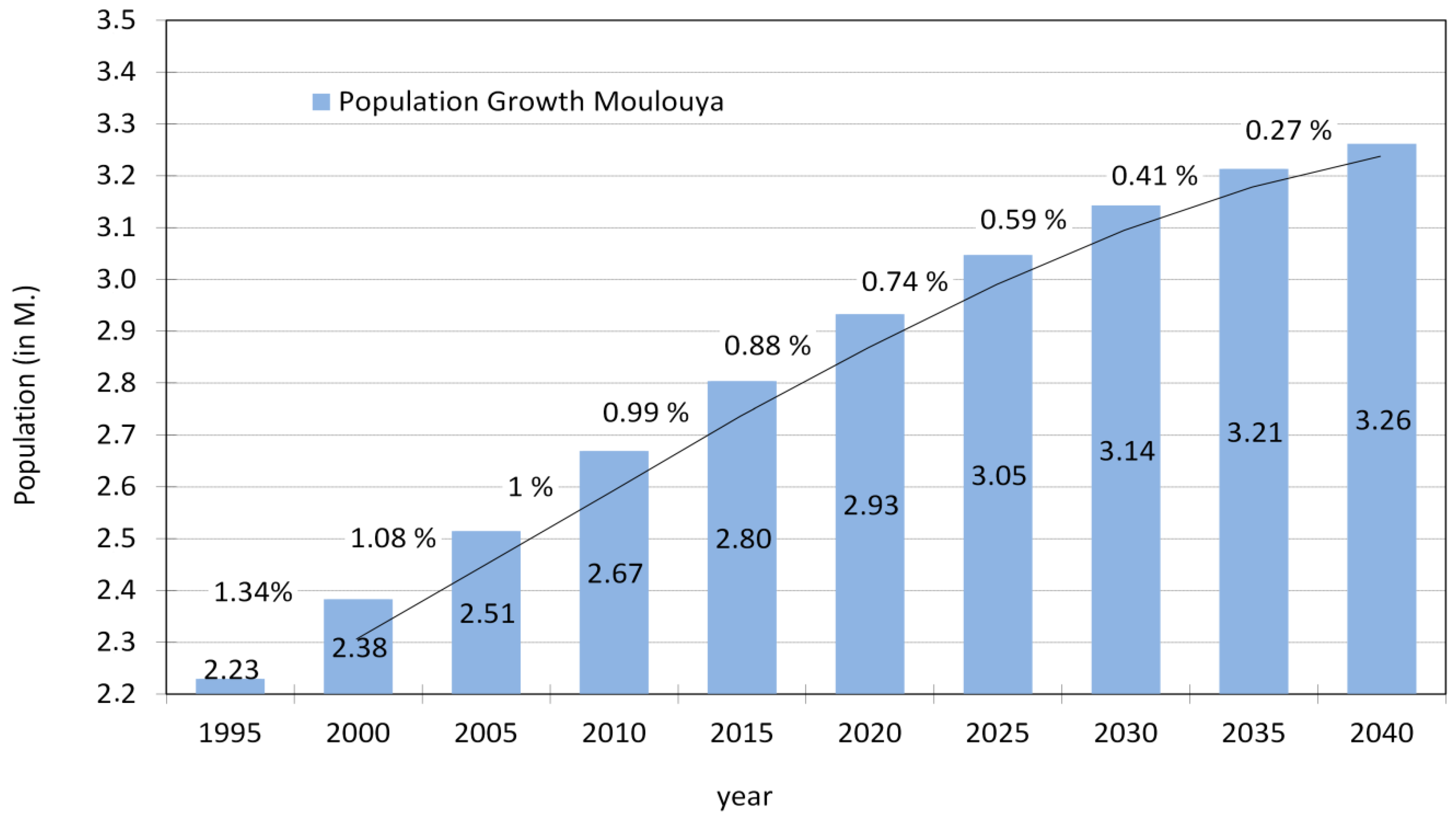
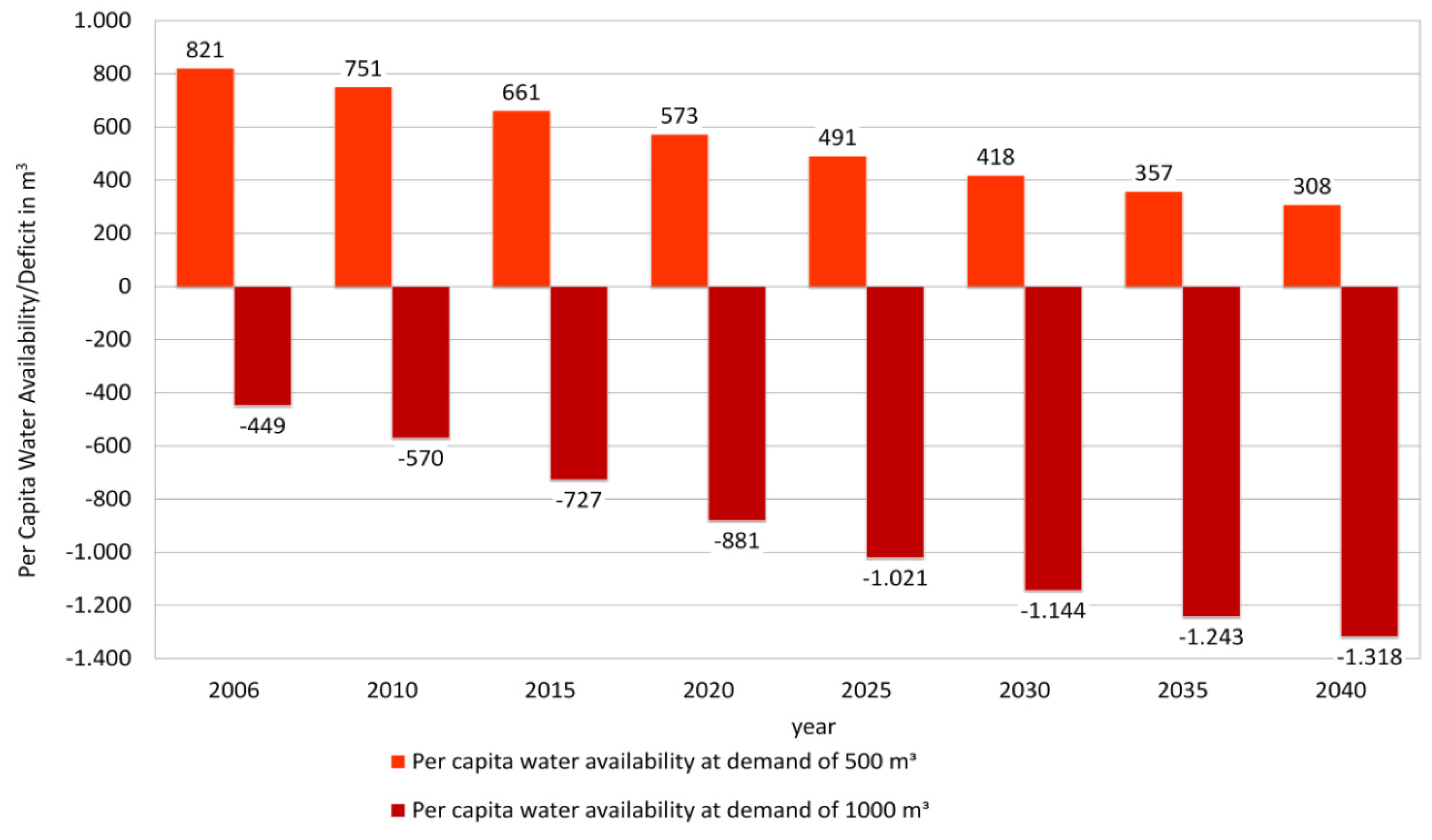
5. Discussion
- A mean annual precipitation decrease for 1971–2005 (−7%);
- A significant decrease of winter precipitation (−21%);
- A slightly significant drying trend for autumn 1971–2005 (−6%);
- A significant temperature increase for December 1971–2005 (+6.8 °C); and
- A 13% decrease of the regional CWB for 1971–2005.
- A very likely increase of regional water demand due to population growth;
- A reinforcing trend of the critical per capita water supply situation (below 500 m3); and
- A very likely establishment of a permanent water deficit situation.
Implications for Regional Water Management
6. Conclusions
Acknowledgments
References
- Arnell, N.W. Climate change and global water resources: SRES emissions and socio-economic scenarios. Glob. Environ. Chang. Hum. Policy Dimens. 2004, 14, 31–52. [Google Scholar] [CrossRef]
- Pratt, J.; Taylor, J.; Catton, W. Carrying capacity and sustainable resource use. In Human Ecology, Environmental Education and Sustainable Development; The 9th Commonwealth Conference on Development and Human Ecology; Daysh, Z., Carley, M., Ekehorn, E., Philipps-Howard, K., Waller, R., Eds.; The Commonwealth Human Ecology Council: London, University of Edinburgh: Edinburgh, UK, 1991; Volume 1, pp. 92–96. [Google Scholar]
- Bogardi, J.J.; Dudgeon, D.; Lawford, R.; Flinkerbusch, E.; Meyn, A.; Pahl-Wostl, C.; Vielhauer, K.; Vörösmarty, C. Water security for a planet under pressure: Interconnected challenges of a changingworld call for sustainable solutions. Curr. Opin. Environ. Sustain. 2012, 4, 35–43. [Google Scholar] [CrossRef]
- Sowers, J.; Vengosh, A.; Weinthal, E. Climate change, water resources, and the politics of adaptation in the Middle East and North Africa. Clim. Chang. 2011, 104, 599–627. [Google Scholar] [CrossRef]
- García-Ruiz, J.M.; López-Moreno, J.I.; Vicente-Serrano, S.M.; Lasanta-Martínez, T.; Beguería, S. Mediterranean water resources in a global change scenario. Earth Sci. Rev. 2011, 105, 121–139. [Google Scholar] [CrossRef] [Green Version]
- Stafford-Smith, M.; Gaffney, O.; Brito, L.; Ostrom, E.; Seitzinger, S. Interconnected risks and solutions for a planet under pressure—Overview and introduction. Curr. Opin. Environ. Sustain. 2012, 4, 3–6. [Google Scholar] [CrossRef]
- Schellnhuber, H.J.M.; Leggewie, C.; Leinfelder, R.; Nakicenovic, N.; Rahmstorf, S.; Schlacke, S.; Schmid, J.; Schubert, R. World in Transition—A Social Contract for Sustainability; German Advisory Council on Global Change (WBGU): Berlin, Germany, 2011. [Google Scholar]
- Falkenmark, M. The massive water scarcity now threatening Africa—Why isn’t it being addressed. Ambio 1989, 18, 112–118. [Google Scholar]
- Beyond Scarcity: Power, Poverty and the Global Water Crisis; United Nations Development Program Human Development Report 2006; United Nations: New York, NY, USA, 2006. Available online: http://hdr.undp.org/en/media/HDR06-complete.pdf (accessed on 13 September 2012).
- Sullivan, C.A. Quantifying water vulnerability: A multi-dimensional approach. Stoch. Environ. Res. Risk Assess. 2011, 25, 627–640. [Google Scholar] [CrossRef]
- Molden, D. Water for Food, Water for Life: A Comprehensive Assessment of Water Management in Agriculture; Earthscan: London, UK; International Water Management Institute (IWMI): Colombo, Sri Lanka, 2007. [Google Scholar]
- Bates, B.C.; Kundzewicz, Z.W.; Wu, S.; Palutikof, J.P. Climate Change and Water; IPCC Technical Paper VI; IPCC Secretariat: Geneva, Switzerland, 2008. Available online: http://www.ipcc.ch/pdf/technical-papers/climate-change-water-en.pdf (accessed on 20 August 2012).
- Alcamo, J.M.; Vorösmarty, C.J.; Naiman, R.J.; Lettenmaier, D.P.; Pahl-Wostl, C. A grand challenge for freshwater research: Understanding the global water system. Environ. Res. Lett. 2008, 3, 1–6. [Google Scholar]
- Fereres, E.; Orgaz, F.; Gonzalez-Dugo, V. Reflections on food security under water scarcity. J. Exp. Bot. 2011, 62, 4079–4086. [Google Scholar] [CrossRef]
- Muller, M. Fit for purpose: Taking integrated water resource management back to basics. Irrig. Drain. Syst. 2010, 24, 161–175. [Google Scholar] [CrossRef]
- Vörösmarty, C.J.; Green, P.; Salisbury, J.; Lammers, R.B. Global water resources: Vulnerability from climate change and population growth. Science 2000, 289, 284–288. [Google Scholar]
- Jackson, R.B.; Carpenter, S.R.; Dahm, C.N.; McKnight, D.M.; Naiman, R.J.; Postel, S.L.; Running, S.W. Water in a changing world. Ecol. Appl. 2001, 11, 1027–1045. [Google Scholar] [CrossRef]
- Falkenmark, M. Global water issues confronting humanity. J. Peace Res. 1990, 27, 177–190. [Google Scholar] [CrossRef]
- Rijsberman, F.R. Water scarcity: Fact or fiction? Agric. Water Manag. 2006, 80, 5–22. [Google Scholar] [CrossRef]
- Diffenbaugh, N.S.; Pal, J.S.; Giorgi, F.; Gao, X.J. Heat stress intensification in the Mediterranean climate change hotspot. Geophys. Res. Lett. 2007, 34, L11706:1–L11706:6. [Google Scholar]
- Snoussi, M. Review of Certain Basic Elements for the Assessment of Environmental Flows in the Lower Moulouya; IUCN International Union for Conservation of Nature: Gland, Switzerland, 2004. Available online: http://cmsdata.iucn.org/downloads/morocco.pdf (accessed on 20 August 2012).
- Kadi, M.A. From water scarcity to water security in the Maghreb Region: The Moroccan Case. In Environmental Challenges in the Mediterranean 2000–2050; NATO Science Series IV; Marquina, A., Ed.; Kluwer Academic Publisher: Dordrencht, The Nertherlands, 2004. [Google Scholar]
- Haut Commissariat au Plan du Maroc Web Page. Recensement Général de la Population et de L’habitat 2004. Available online: http://www.hcp.ma/Recensement-general-de-la-population-et-de-l-habitat-2004_a633.html (accessed on 20 August 2012).
- FAO/AQUASTAT. Information System on Water and Agriculture, Water Resources and Irrigation in Africa. Available online: http://www.fao.org/nr/water/aquastat/main/index.stm (accessed on 20 August 2012).
- Born, K.; Fink, A.H.; Paeth, H. Dry and wet periods in the northwestern Maghreb for present day and future climate conditions. Meteorol. Z. 2008, 17, 533–551. [Google Scholar] [CrossRef]
- Royaume du Maroc. Plan Azur: Référentiel Développement Durable Pour les Nouvelles Zones Touristiques à Horizon 2010—Principes de Développement Touristique Durable cas Marocain. In SMAP III TA Regional Workshop on Sustainable Tourism, Istanbul, Turkey, 19-21 February 2008.
- Plan Maroc Vert: Premières Perspectives sur la Stratégie Agricole; Ministère de l’Agriculture: Rabat, Morocco, 2008. Available online: http://www.europarl.europa.eu/meetdocs/2009_2014/documents/dmag/dv/dmag20100505_13_/dmag20100505_13_fr.pdf (accessed on 20 August 2012).
- Khrouz, D.; Hajji, A.; Boussetta, M. The development research environment in Morocco: Situation and prospects. Rached, E.; Craissati, D. IDRC International Development Research Centre: Ottawa, Canada, 2000, 2000; pp. 161–185. Available online: http://archive.idrc.ca/books/focus/930/16khrouz.html (accessed on 20 August 2012).
- Falkenmark, M. Coping with water scarcity under rapid population growth. In Proceedings ofConference of SADC Ministers, Pretoria, South Africa, 23-24 November 1995.
- Willaarts, B.A.; Volk, M.; Aguilera, P.A. Assessing the ecosystem services supplied by freshwater flows in Mediterranean agroecosystems. Agric. Water Manag. 2012, 105, 21–31. [Google Scholar] [CrossRef]
- Sullivan, C.A.; Meigh, J.R.; Giacomello, A.M.; Fediw, T.; Lawrence, P.; Samad, M.; Mlote, S.; Hutton, C.; Allan, J.A.; Schulze, R.E.; et al. The water poverty index: Development and application at the community scale. Nat. Resour. Forum 2003, 27, 189–199. [Google Scholar]
- Hoff, H.; Bonzi, C.; Joyce, B.; Tielbörger, K. A water resources planning tool for the Jordan River Basin. Water 2011, 3, 718–736. [Google Scholar] [CrossRef]
- Melhaoui, M. Integration of Biodiversity in the Decision-Making Process: Lessons Learnt from the Moulouya Projects; Centre for Mediterranean Cooperation, International Union for Conservation of Nature: Gland, Switzerland, 2010. Available online: http://cmsdata.iucn.org/downloads/.
- Tekken, V.; Costa, L.; Kropp, J.P. Assessing the regional impacts of climate change on economic sectors in the low-lying coastal zone of Mediterranean East Morocco. J. Coast. Res. 2009, 1, 272–276. [Google Scholar]
- Köppen, W. Das geographische system der klimate. In Handbuch der Klimatologie; Köppen, W.P., Geiger, R.H., Eds.; Gebrüder Borntraeger: Berlin, Germany, 1936. [Google Scholar]
- Snoussi, M.; Haida, S.; Imassi, S. Effects of the construction of dams on the water and sediment fluxes of the Moulouya and the Sebou Rivers, Morocco. Reg. Environ. Chang. 2002, 3, 5–12. [Google Scholar] [CrossRef]
- Carneiro, J.F.; Boughriba, M.; Correia, A.; Zarhloule, Y.; Rimi, A.; Houadi, B.E. Evaluation of climate change effects in a coastal aquifer in Morocco using a density-dependent numerical model. Environ. Earth Sci. 2010, 61, 241–252. [Google Scholar] [CrossRef]
- RAMSAR Wetlands International. The Ramsar Sites Database. Available online: http://ramsar.wetlands.org/Database/Searchforsites/tabid/765/Default.aspx (accessed on 20 August 2012).
- National Plan against Global Warming; Royaume du Maroc: Rabat, Morocco, 2009.
- Arnell, N.W. Climate change and global water resources. Glob. Environ. Chang. Hum. Policy Dimens. 1999, 9, S31–S49. [Google Scholar] [CrossRef]
- Alcamo, J.; Florke, M.; Marker, M. Future long-term changes in global water resources driven by socio-economic and climatic changes. Hydrol. Sci. J. 2007, 52, 247–275. [Google Scholar] [CrossRef]
- Hoekstra, A.Y.; Mekonnen, M.M.; Chapagain, A.K.; Mathews, R.E.; Richter, B.D. Global monthly water scarcity: Blue water footprints versus blue water availability. PLoS ONE 2012, 7, e32688:1–e32688:9. [Google Scholar]
- White, C. Understanding water scarcity: Definitions and measurements; GWF Discussion Paper 1217. Global Water Forum: Canberra, Australia, 2012. Available online: http://www.globalwaterforum.org/ 2012/05/07/understanding-water-scarcity-definitions-and-measurements/ (accessed on 7 October 2012).
- Savenije, H.H.G. Water scarcity indicators; The deception of the numbers. Phys. Chem. Earth Part B Hydrol. Ocean. Atmos. 2000, 25, 199–204. [Google Scholar] [CrossRef]
- Hoekstra, A.Y. Virtual water trade. In Proceedings of the International Expert Meeting on Virtual Water Trade, Delft, The Netherlands, 12–13 December 2002.
- Ohlsson, L. Water conflicts and social resource scarcity. Phys. Chem. Earth Part B Hydrol. Ocean. Atmos. 2000, 25, 213–220. [Google Scholar] [CrossRef]
- Alcamo, J.; Henrichs, T.; Rosch, T. World Water in 2025: Global Modeling and Scenario Analysisfor the World Commission on Water for the 21st Century; Centre for Environmental Systems Research, University of Kassel: Kassel, Germany, 2000; pp. 1–49. [Google Scholar]
- Gleick, P.H.; Chalecki, E.L.; Wong, A. Measuring water well-being: Water indicators and indices. In The World’s Water, 2002–2003: The Biennal Report on Freshwater Resources; Gleick, P.H., Ed.; Island Press: Washington, DC, USA, 2002; pp. 87–112. [Google Scholar]
- Brown, A.; Matlock, M.D. A Review of Water Scarcity Indices and Methodologies; The Sustainability Consortium,University of Arkansas: Fayetteville, AK, USA, 2011. Available online: http://www.sustainabilityconsortium.org/wp-content/themes/sustainability/assets/pdf/whitepapers/ 2011_Brown_Matlock_Water-Availability-Assessment-Indices-and-Methodologies-Lit-Review.pdf (accessed on 7 October 2012).
- Sagar, A.D.; Najam, A. The human development index: A critical review. Ecol. Econ. 1998, 25, 249–264. [Google Scholar] [CrossRef]
- Falkenmark, M.; Widstrand, C. Population and water resources: A delicate balance. Popul. Bull. 1992, 47, 2–36. [Google Scholar]
- Vorösmarty, C.J.; Douglas, E.M.; Green, P.A.; Revenga, C. Geospatial indicators of emerging water stress: An application to Africa. Ambio 2005, 34, 230–236. [Google Scholar]
- Taylor, R.G.; Koussis, A.D.; Tindimugaya, C. Groundwater and climate in Africa—A review. Hydrol. Sci. J. 2009, 54, 655–664. [Google Scholar] [CrossRef]
- Eurostat/European Commission. MEDSTAT II: “Water and Tourism” Pilot Study; Office for Official Publications of the European Communities: Luxembourg, 2009. Available online: http://epp.eurostat.ec.europa.eu/cache/ITY_OFFPUB/KS-78-09-699/EN/KS-78-09-699-EN.PDF (accessed on 20 August 2012).
- New, M.; Lister, D.; Hulme, M.; Makin, I. A high-resolution data set of surface climate over global land areas. Clim. Res. 2002, 21, 1–25. [Google Scholar] [CrossRef]
- Mitchell, T.D.; Jones, P.D. An improved method of constructing a database of monthly climate observations and associated high-resolution grids. Int. J. Climatol. 2005, 25, 693–712. [Google Scholar] [CrossRef]
- sterle, H.; Gerstengarbe, F.-W.; Werner, P.C. Homogenisierung und aktualisierung des klimadatensatzes der climate research unit der Universität of East Anglia, Norwich, UK. Terra Nostra 2003, 6, 326–329. [Google Scholar]
- Imassi, S. Variabilité Hydroclimatique et Impacts des Activités Anthropiques sur les Resources en eau de la Basse Moulouya (Maroc Oriental). Ph.D. thesis, Mohammed V University at Agdal, Rabat, Morocco, 2007. [Google Scholar]
- L’irrigation en Afrique en Chiffres. FAO Rapports Sur L’eau 29. Food and Agriculture Organization: Rome, Italy, 2005. Available online: ftp://ftp.fao.org/agl/aglw/docs/wr29_fre.pdf (accessed on 20 August 2012).
- UN-Water/Africa, African Water Development Report 2006; UN-Water/Africa, Economic Commission for Africa: Addis Ababa, Ethiopia, 2006.
- United Nations Population Division. World Population Prospects: The 2010 Revision Population Database; UN Department of Economic and Social Affairs of the United Nations Secretariat: New York, NY, USA, 2011. Available online: http://esa.un.org/wpp/unpp/panel_population.htm (accessed on 20 August 2012).
- Le Maroc des Régions 2005; Direction De La Statistique; Haut Commissariat Au Plan: Rabat, Morocco, 2005.
- Thornthwaite, C.W. An approach toward a rational classification of climate. Geogr. Rev. 1948, 38, 55–94. [Google Scholar] [CrossRef]
- Bautista, F.; Bautista, D.; Delgado-Carranza, C. Calibration of the equations of Hargreaves and Thornthwaite to estimate the potential evapotranspiration in semi-arid and subhumid tropical climates for regional applications. Atmosfera 2009, 22, 331–348. [Google Scholar]
- Leichenko, R.; O’Brien, K.; Aandahl, G.; Tompkins, H.; Javed, A. Mapping Vulnerability to Multiple Stressors: A Technical Memorandum; CICERO: Oslo, Norway, 2004. [Google Scholar]
- World Water Assessment Programme (WWAP), The United Nations World Water Development Report 4: Managing Water Under Uncertainty and Risk; UNESCO Publishing: Paris, France, 2012.
- Trieb, F.; Muller-Steinhagen, H.; Kern, J.; Scharfe, J.; Kabariti, M.; Al Taher, A. Technologies forlarge scale seawater desalination using concentrated solar radiation. Desalination 2009, 235, 33–43. [Google Scholar] [CrossRef]
- Sullivan, C.A.; Huntingford, C. Water resources,climate change and human vulnerability. Proceedings of 18th World IMACS Congress and MODSIM09 International Congress on Modelling and Simulation, Cairns, Australia, 13-17 July 2009; pp. 2377–2383. Available online: http://www.mtnforum.org/sites/default/files/pub/5034.pdf (accessed on 20 August 2012).
- Qadir, M.; Bahri, A.; Sato, T.; Al-Karadsheh, E. Wastewater production, treatment, and irrigation in Middle East and North Afria. Irrig. Drain. Syst. 2010, 24, 37–51. [Google Scholar] [CrossRef]
- Agence du Bassin Hydraulique de la Moulouya Home Page. Available online: http://www.abhm.ma (accessed on 22 November 2012).
- Etude du Plan Directeur d’Aménagement Intégré des Ressources en Eau du Bassin de la Moulouya (PDAIRE); Agence du Bassin Hydraulique de la Moulouya: Oujda, Morocco, 2009. Available online: http://www.eaumoulouya.ma/TermReferPDAIREMoulouyal.htm (accessed on 22 November 2012).
© 2012 by the authors; licensee MDPI, Basel, Switzerland. This article is an open-access article distributed under the terms and conditions of the Creative Commons Attribution license (http://creativecommons.org/licenses/by/3.0/).
Share and Cite
Tekken, V.; Kropp, J.P. Climate-Driven or Human-Induced: Indicating Severe Water Scarcity in the Moulouya River Basin (Morocco). Water 2012, 4, 959-982. https://doi.org/10.3390/w4040959
Tekken V, Kropp JP. Climate-Driven or Human-Induced: Indicating Severe Water Scarcity in the Moulouya River Basin (Morocco). Water. 2012; 4(4):959-982. https://doi.org/10.3390/w4040959
Chicago/Turabian StyleTekken, Vera, and Jürgen P. Kropp. 2012. "Climate-Driven or Human-Induced: Indicating Severe Water Scarcity in the Moulouya River Basin (Morocco)" Water 4, no. 4: 959-982. https://doi.org/10.3390/w4040959




